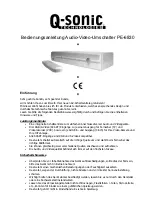
Page 30
Voyager OS User’s Manual - The Components
Page 31
Voyager OS User’s Manual - The Components
H – Keyboard and Left-Hand Controllers
The Voyager OS has a 44-note keyboard (31⁄2 octaves,
F to C), just like the original Minimoog. The Voyager’s key-
board produces velocity and aftertouch (pressure) voltages
monophonically.
These voltages can be used as modulation
control signals through the Modulation Busses, or as external
control signals when the Voyager is connected to the optional
VX-351 CV Expander.
To the left of the keyboard is the Left Hand Controller Panel,
which contains the Pitch Bend and Mod Wheel performance
controls, and the Glide and Release switches.
Keyboard Modes
The Voyager OS keyboard priority is LAST NOTE, and the trigger mode is LEGATO. ‘Last Note’ means that
each new note on the keyboard generates a new pitch CV. ‘Legato’ means that as long as any combina-
tion of notes on the keyboard is held down, the keyboard Gate signal is high (in other words, Single Trigger
mode). The Voyager OS can also be confi gured for Multi Trigger mode. ‘Multi Trigger’ means that each new
note played on the keyboard re-triggers the Gate. To place the Voyager OS in Multi Trigger mode, simply
hold down the top two keys of the keyboard as the unit is powered up. The Voyager will revert to Single
Trigger mode the next time the unit is powered up unless the top two keys of the keyboard are held down.
Performance Controls
Pitch Bend Wheel:
This spring-loaded performance control affects the pitch of all three oscillators. The pitch bend amount is
fi xed at +/-5 semitones.
Note:
The Pitch Bend amount is set by an internal jumper. Although most players will be comfortable
with the factory default setting (+/-5 semitones), wider or narrower ranges can be set by reconfi guring
an internal jumper. For details on this procedure, visit the Voyager Old School section on the Moog
Music web site (www.moogmusic.com).
Modulation Wheel:
This performance control adjusts the amount of modulation that is sent to the modulation destination when
the Mod Buss
CONTROLLER
switch is set to ‘MOD WHEEL’.
Glide:
The
GLIDE
switch turns the Glide function ON and OFF. The glide rate is controlled by the
GLIDE RATE
panel control.
Release:
The
RELEASE
switch is used to shorten the release time of both the Filter and Volume envelopes. You will
notice that with very long release times, the release time will be shortened when the
RELEASE
switch is
engaged.
















































